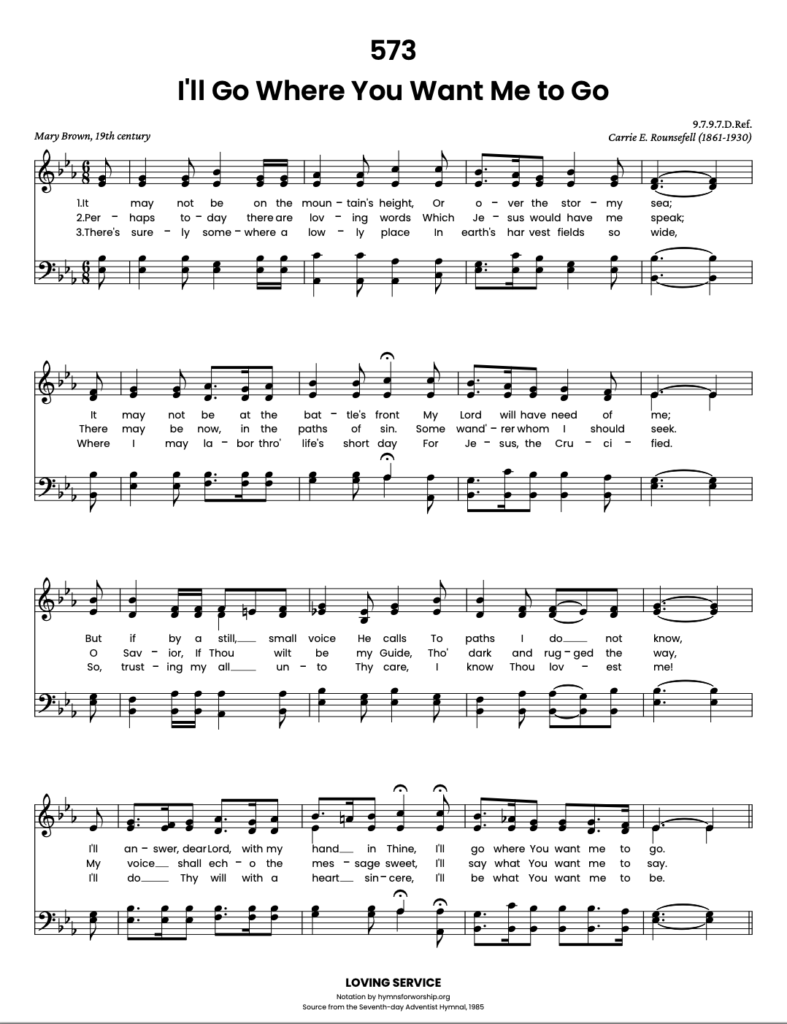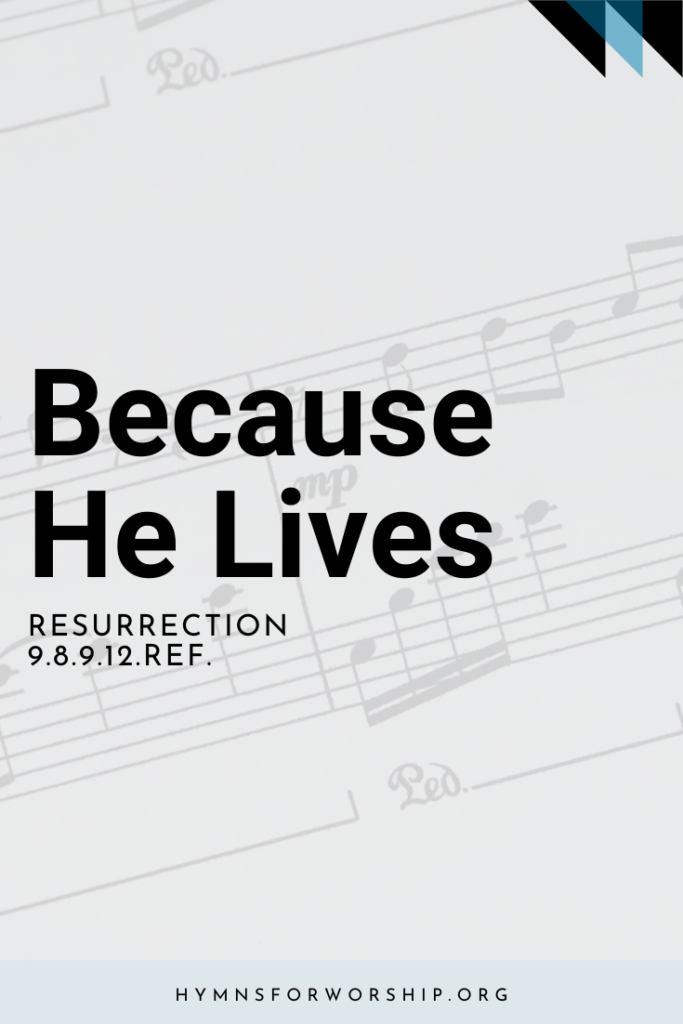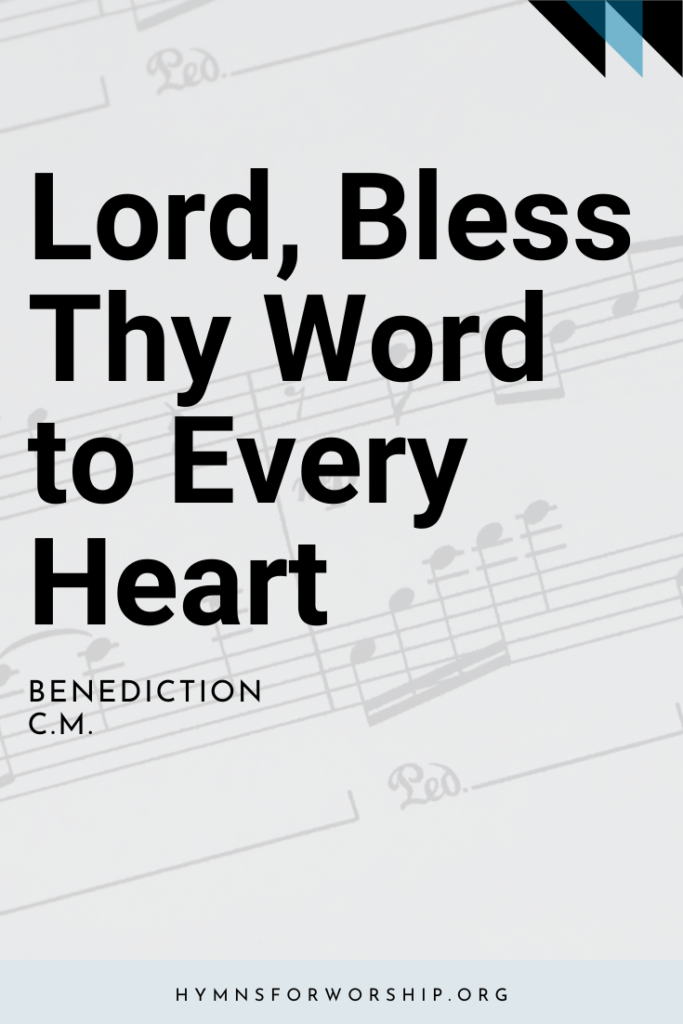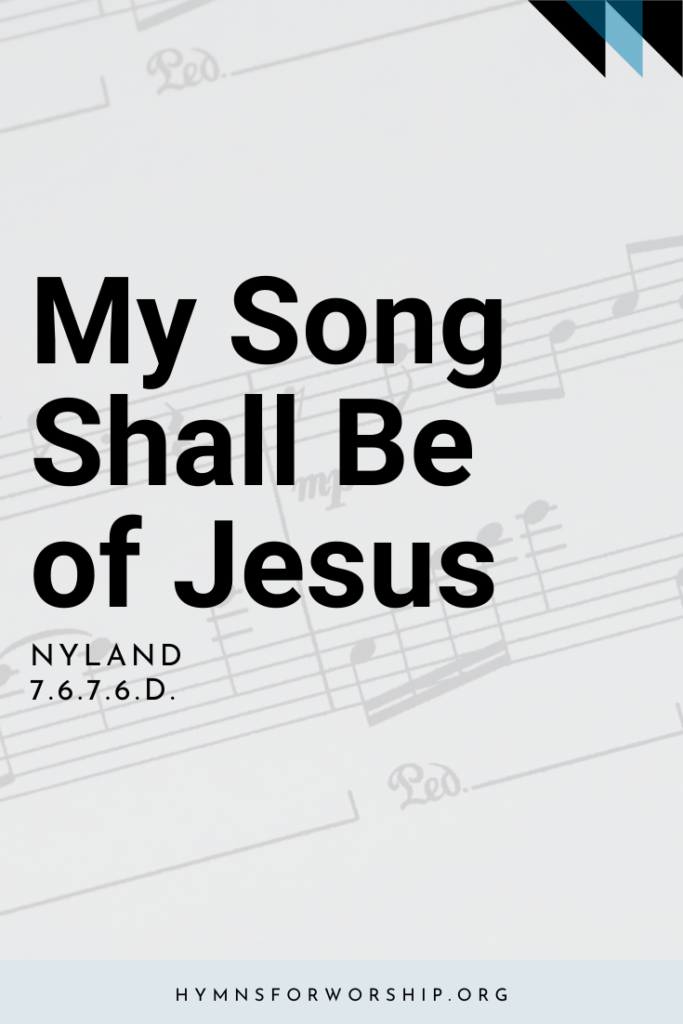CHRISTIAN LIFE >> LovING SERVICE
SDAH 573
It may not be on the mountain height
Or over the stormy sea,
It may not be at the battle’s front
My Lord will have need of me.


Text
1
It may not be on the mountain height
Or over the stormy sea,
It may not be at the battle’s front
My Lord will have need of me.
But if, by a still, small voice he calls
To paths that I do not know,
I’ll answer, dear Lord, with my hand in thine;
I’ll go where you want me to go.
Refrain
I’ll go where you want me to go, dear Lord,
Over mountain or plain or sea;
I’ll say what you want me to say, dear Lord;
I’ll be what you want me to be.
2
Perhaps today there are loving words
Which Jesus would have me speak
There may be now in the paths of sin
Some wand’rer whom I should seek.
O Savior, if thou wilt be my guide,
Tho dark and rugged the way,
My voice shall echo the message sweet;
I’ll say what you want me to say.
3
There’s surely somewhere a lowly place
In earth’s harvest fields so wide
Where I may labor through life’s short day
For Jesus, the Crucified.
So trusting my all to thy tender care,
And knowing thou lovest me,
I’ll do thy will with a heart sincere:
I’ll be what you want me to be.

Hymn Info
Biblical Reference
(r) Isa 6:8
Author
Mary Brown
Year Published
18th century
Metrical Number
9.7.9.7.D.Ref.
Composer
Carrie E. Rounsefell (1861-1930)

Get the hymn sheet in other keys here
Notes
Make each hymn more meaningful with these helpful tools: Short, ready-to-use hymn introductions for church bulletins, multiple ways to introduce a hymn based on your worship theme and in-depth history and insights to enrich your song service.
Mary Brown, author of this hymn of consecration to service, is thought to have lived in Jewett City, Connecticut, during the last part of the nineteenth century, but nothing more about her is known. In Hymns of Our Faith, 1964, William Reynolds says that stanzas 2 and 3 were written by Charles Edwin Prior, born near Moosup, Connecticut, January 27, 1856. He was a savings bank official in Jewett City, and played the organ and directed music in the Congregational and Baptist churches of that city. Besides writing several songs, he published these collections of Sunday school songs: Spicy Breezes, 1883; Sparkling and Bright, 1890; and Our Best Endeavor, 1892. At Hartford, Connecticut, he served as president of the Baptist Union, and directed the music at the annual meetings of the Baptist Sunday School Union at Crescent Beach. He died at Bridgeport, Connecticut, June 27, 1927.
Carrie Esther Rounsefell, born at Merrimac, New Hampshire, March 1, 1861, was reared in Manchester, New Hampshire. Her husband was a bookkeeper for a paint and wallpaper company. A tiny woman, she traveled all over the northeast as a singing evangelist, accompanying herself on an autoharp. In late life she became a member of the Church of God, and lived in Durham, Maine, where she died September 18, 1930.
During a revival meeting in the Baptist church at Lynn, Massachusetts, the pastor gave Rounsefell the first stanza of Mary Brown’s hymn and suggested she write a tune for it. Later she recalled: “I took the words, got down before the Lord with my little autoharp, asked Him to give me a tune, and this music was the answer.” The hymn was sung in the service that evening; later it was printed in a song sheet, and from there it has made its way into many hymnals around the world. Its challenging words served as inspiration for another gospel singer, Homer Rodeheaver, who wrote in his Hymnal Handbook for Standard Gospel Songs, 1931: “One of the very first gospel songs that I ever heard after I left my home in the mountains of east Tennessee was ‘I’ll Go Where You Want Me to Go.’ It was the singing of a boy by a singer named Ellis, in a young people’s meeting at Ohio Wesleyan University, Delaware, Ohio, in 1897, that gave me my first urge to become a gospel singer.” Rodeheaver recalled that “on the golf course in Florida one day, Mr. John D. Rockefeller told me this was one of his favorite songs. He asked me to sing it for a group of folks who had gathered to meet and greet him. He joined and sang the chorus with us.”
Ira D. Sankey (see Biographies) tells about his visit to the Battle Creek (Michigan) Sanitarium where “this well-known missionary and consecration hymn was adopted by a class of more than 100 missionary nurses as their class hymn. Every Sunday afternoon they would gather for a social meeting and always sing, ‘I’ll go where Thou would’st I should go, dear Lord’ [possibly the original wording], which they called ‘their hymn.’ In this class were students from nearly every state of the Union, from Australia, South Africa, South America, Bulgaria, Armenia, and nearly all European countries. At the close of the course they agreed that after they had parted and gone to their different fields, they would sing this hymn every Sunday afternoon, as they had done in their happy class days.”
The Lord Himself also becomes a Servant in this world. He experienced suffering just as we are and still found faithful till the end. He is indeed our great example that we may have hope as serve Him today. (Lesson 9, 1st Quarter 2021 -Thursday, A Feeling and Suffering Servant, 2/25/2021)




